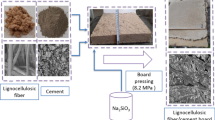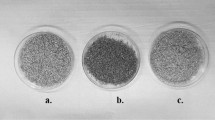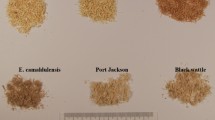Abstract
The excellent properties of geopolymer composites and their ability to be synthesized from various industrial waste streams make them promising green binders in wood-based composite manufacturing. The study characterized 100% slag unary precursor-based geopolymers reinforced with lignocellulosic material residue. The residue included sugarcane bagasse (SCB), Port Jackson (Acacia saligna) and Black wattle (Acacia mearnsii). The production process was established based on a mixed factorial design using Statistica 13.3. The factors considered included a curing pattern at 2 levels, sodium hydroxide concentration at 3 levels and lignocellulose material at 3 levels. Other parameters, such as precursor-activator ratio and sodium hydroxide-silicate ratio were constant. Statistical analysis revealed that curing temperature and sodium hydroxide concentration had a significant effect on the board properties and the addition of lignocellulose material improved the flexural strength. Curing at 40 °C influenced the reaction kinetics, enhanced microstructural properties, and produced a dense geopolymeric matrix which resulted in improved physical and mechanical properties. However, increasing the sodium hydroxide concentration beyond 6 M caused efflorescence and deteriorated the mechanical property of A. mearnsii and bagasse boards. Partial degradation of the fibres was confirmed by Fourier transform infrared spectroscopy and thermogravimetric analysis, but the degraded products did not inhibit geopolymer setting. Scanning electron microscopy indicated a uniform board structure surrounded with micro crystals of calcium silicate hydrate (C–S–H). A. saligna boards produced with 6 M NaOH and cured at 40 °C met the technical specification of cement-bonded particleboards for outdoor applications according to the British standard EN 634–2.


















Similar content being viewed by others
References
Aiken TA, Sha W, Kwasny J, Soutsos MN (2017) Resistance of geopolymer and Portland cement based systems to silage effluent attack. Cem Concr Res 92:56–65. https://doi.org/10.1016/j.cemconres.2016.11.015
Allahverdi A, Kani E, Yazdanipour M (2011) Effects of blast furnance slag on natural pozzolan- based geopolymer cement. Ceramics-Silickáty 55(1):68–78
Alomayri T (2017) Effect of glass microfibre addition on the mechanical performances of fly ash-based geopolymer composites. J Asian Ceram Soc 5(3):334–340. https://doi.org/10.1016/j.jascer.2017.06.007
Amiandamhen SO, Meincken M, Tyhoda L (2016) Magnesium based phosphate cement binder for composite panels: A response surface methodology for optimisation of processing variables in boards produced from agricultural and wood processing industrial residues. Ind Crops Prod 94:746–754. https://doi.org/10.1016/j.indcrop.2016.09.051
Amiandamhen SO, Meincken M, Tyhoda L (2018a) The effect of chemical treatments of natural fibres on the properties of phosphate-bonded composite products. Wood Sci Technol 52(3):653–675. https://doi.org/10.1007/s00226-018-0999-9
Amiandamhen SO, Montecuccoli Z, Meincken M, Barbu MC, Tyhoda L (2018b) Phosphate bonded wood composite products from invasive Acacia trees occurring on the Cape Coastal plains of South Africa. Eur J Wood Prod 76:437–488. https://doi.org/10.1007/s00107-017-1191-x
Andini S, Cioffi R, Colangelo F, Grieco T, Montagnaro F, Santoro L (2008) Coal fly ash as raw material for the manufacture of geopolymer-based products. Waste Manage. https://doi.org/10.1016/j.wasman.2007.02.001
ANSI-A208.1 (1999) Particleboards. American National Standard, Composite Panel Association
ASTM (2013) ASTM D1037: Standard test methods for evaluating properties of wood-base fiber and particle. In Annual Book of ASTM Standards (issue July). https://doi.org/10.1520/D1037-99
Bilim C, Karahan O, Atiş CD, Ilkentapar S (2013) Influence of admixtures on the properties of alkali-activated slag mortars subjected to different curing conditions. Mater Des 44:540–547. https://doi.org/10.1016/j.matdes.2012.08.049
Bledzki AK, Gassan J (1999) Composites Reinforced with Cellulose Based Fibers. Prog Polym Sci 24:221–274
Bledzki AK, Gassan J, Theis S (1998) Wood-filled Thermoplastic Composites. Mech Compos Mater 34(13):563–568
Chen R, Ahmari S, Zhang L (2014) Utilization of sweet sorghum fiber to reinforce fly ash-based geopolymer. J Mater Sci 49(6):2548–2558. https://doi.org/10.1007/s10853-013-7950-0
Cioffi R, Maffucci L, Santoro L (2003) Optimization of geopolymer synthesis by calcination and polycondensation of a kaolinitic residue. Resour Conserv Recycl. https://doi.org/10.1016/S0921-3449(03)00023-5
Criado M, Palomo A, Fernández-Jiménez A (2005) Alkali activation of fly ashes. Part 1: Effect of curing conditions on the carbonation of the reaction products. Fuel 84(16):2048–2054. https://doi.org/10.1016/j.fuel.2005.03.030
Davidovits J (2008) Geopolymer Chemistry and Applications (3rd ed.). Institute Geopolymere, Saint-Quentin, France
DEA (2012) National Waste Information Baseline Report. Pretoria: Department of Environmental Affairs.
EN634–2 (2007) Cement-bonded particleboards –Specifications- Part 2: Requirements for OPC bonded particleboards for use in dry, humid and external conditions. British Standards
Fernandez-Jimenez A, Monzo M, Vicent M, Barba A, Palomo A (2008) Alkaline Activation of Metakaolin-Fly Ash Mixtures: Obtain of Zeoceramics and Zeocements. Microp Mesop Mater 108:41–49
Guo X, Pan X (2018) Mechanical properties and mechanisms of fiber reinforced fly ash–steel slag based geopolymer mortar. Constr Build Mater 179:633–641. https://doi.org/10.1016/j.conbuildmat.2018.05.198
Komnitsas KA (2011) Potential of geopolymer technology towards green buildings and sustainable cities. Procedia Eng 21:1023–1032. https://doi.org/10.1016/j.proeng.2011.11.2108
Korniejenko K, Mikuła J, Łach M (2015) Fly ash based fiber-reinforced geopolymer composites as the environmental friendly alternative to cementitious materials. Proceed 2015 Int Conf Bio-Med Eng Environm Technol 164–171
Lamas WDQ, Palau JCF, De Camargo JR (2013) Waste materials co-processing in cement industry: Ecological efficiency of waste reuse. Renew Sustain Energy Rev 19:200–207. https://doi.org/10.1016/j.rser.2012.11.015
Li YL, Zhao XL, Singh Raman RK, Al-Saadi S (2018) Thermal and mechanical properties of alkali-activated slag paste, mortar and concrete utilising seawater and sea sand. Constr Build Mater 159:704–724. https://doi.org/10.1016/j.conbuildmat.2017.10.104
Machado G, Santos F, Faria D, De Queiroz TN, Zinani F, De Queiroz JH, Gomes F (2018) Characterization and potential evaluation of residues from the sugarcane industry of Rio Grande do Sul in biorefinery processes. Nat Resour. https://doi.org/10.4236/nr.2018.95011
Miranda I, Gominho J, Mirra I, Pereira H (2012) Chemical characterization of barks from Picea abies and Pinus sylvestris after fractioning into different particle sizes. Ind Crops Prod 36:395–400. https://doi.org/10.1016/j.indcrop.2011.10.035
Na B, Wang Z, Wang Z, Ding T, Huang R, Xiaoling L (2014) Study on hydration mechanism of low density magnesia-bonded wood wool panel. Wood Research 59(1):137–147
Olayiwola HO, Amiandamhen SO, Tyhoda L, Meincken M (2021) Investigating the suitability of fly ash / metakaolin - based geopolymers reinforced with South African alien invasive wood and sugarcane bagasse residues for use in outdoor conditions. Eur J Wood Prod 79:611–627. https://doi.org/10.1007/s00107-020-01636-4
Pereira Ferraz G, Frear C, Pelaez-Samaniego MR, Englund K, Garcia-Perez M (2016) Hot water extraction of anaerobic digested dairy fiber for wood plastic composite manufacturing. BioResources 11(4):8139–8154. https://doi.org/10.15376/biores.11.4.8139-8154
Petermann JC, Saeed A (2012) Alkali-activated geopolymers: a literature review. Air Force Research Laboratory, Feb 1–99
Provis JL, Van Deventer JSJ (2014). Alkali Activat Mater. https://doi.org/10.1007/978-94-007-7672-2
Quiroga A, Marzocchi V, Rintoul I (2016) Influence of wood treatments on mechanical properties of wood-cement composites and of Populus Euroamericana wood fibers. Compos B Eng 84:25–32. https://doi.org/10.1016/j.compositesb.2015.08.069
Rashad AM (2015) Influence of different additives on the properties of sodium sulfate activated slag. Constr Build Mater 79:379–389. https://doi.org/10.1016/j.conbuildmat.2015.01.022
Sariatli F (2017) Linear economy versus circular economy: a comparative and analyzer study for optimization of economy for sustainability. Visegrad J Bioecon Sustain Develop 6(1):31–34. https://doi.org/10.1515/vjbsd-2017-0005
Shi Z, Shi C, Wan S, Li N, Zhang Z (2018) Effect of alkali dosage and silicate modulus on carbonation of alkali-activated slag mortars. Cem Concr Res 113(July):55–64. https://doi.org/10.1016/j.cemconres.2018.07.005
Simatupang MH, Geimer RL (1990) Inorganic binder for wood composites: feasibility and limitations. Proceedings of Wood Adhesive Symposium, 169–176. http://www.fpl.fs.fed.us/products/publications/specific_pub.php?posting_id=15141&header_id=p
Song S, Sohn D, Jennings HM, Mason TO (2000) Hydration of alkali-activated ground granulated blast furnace slag. J Mater Sci 35(1):249–257. https://doi.org/10.1023/A:1004742027117
T211 (2012). Ash in wood, pulp, paper and paperboard: combustion at 525°C. Tappi Standards
Tran DH, Louda P, Bortnovsky O, Bezucha P (2009) Effect of curing temperature on flexural properties of silica-based geopolymer-carbon reinforced composite. Manuf Eng 37(2):492–497
Turku I, Keskisaari A, Kärki T, Puurtinen A, Marttila P (2016) Characterization of wood plastic composites manufactured from recycled plastic blends. Compos Struct 161:469–476. https://doi.org/10.1016/j.compstruct.2016.11.073
Yazdi MA, Liebscher M, Hempel S, Yang J, Mechtcherine V (2018) Correlation of microstructural and mechanical properties of geopolymers produced from fly ash and slag at room temperature. Constr Build Mater 191:330–341. https://doi.org/10.1016/j.conbuildmat.2018.10.037
Funding
This study was funded by the German Federan Ministry of Education and Research, Grant no: 01DG17007A, Martina Meincken, DAAD Project, Grant no: 57359374, Martina Meincken.
Author information
Authors and Affiliations
Corresponding author
Additional information
Publisher's Note
Springer Nature remains neutral with regard to jurisdictional claims in published maps and institutional affiliations.
Rights and permissions
About this article
Cite this article
Olayiwola, H.O., Amiandamhen, S.O., Meincken, M. et al. Characterization of unary precursor-based geopolymer bonded composite developed from ground granulated blast slag and lignocellulosic material residues. Eur. J. Wood Prod. 80, 377–393 (2022). https://doi.org/10.1007/s00107-021-01778-z
Received:
Accepted:
Published:
Issue Date:
DOI: https://doi.org/10.1007/s00107-021-01778-z




